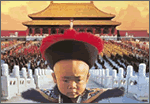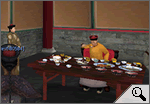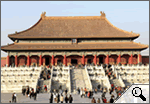|
|
|
|
 |
 |
 > An Interactive and Participative Initiative > Almost Ten Thousand Rooms! > The Forbidden City and 'The Last Emperor' dijous, 30 d'octubre de 2008
The Forbidden City in Beijing is one of the greatest cultural and architectural treasures in China. Today, this enormous complex of palaces is home to the Palace Museum. Now, where several centuries ago this great masterpiece was inaccessible to ordinary people, today the general public is able to visit every nook and cranny of it thanks to a digitisation initiative that has been launched this October.
The project, called 'The Forbidden City: Beyond Space and Time', is the work of the computer company IBM in partnership with the Palace Museum. It has taken three years to complete at a cost of $3m. The result is a virtual, three-dimensional recreation that allows visitors to take a virtual tour around the Forbidden City, looking at its history and at what's inside, all in high-resolution images. 'The Forbidden City: Beyond Space and Time' is a free programme that can be downloaded from the Internet for Windows, Mac and Linux users. The official website specifies technical requirements to be able to download the programme and see it correctly.
An Interactive and Participative InitiativeThe first thing users of 'The Forbidden City: Beyond Space and Time' need to do is choose a character from the Chinese court. They can then start to explore five centuries of civilisation, either on their own or with the help of a tour guide. The programme lets users interact with each other and take photos, just like a real-life tourist. Virtual visitors can take part in various activities, like using a bow and arrow, or study traditional scenes of daily life at the palace, such as the emperor's banquets.
Almost Ten Thousand Rooms!Located in the heart of Beijing and surrounded by walls, the Forbidden City was the official residence of Chinese emperors from 1420 until 1911, during the Ming and Qing dynasties. The name Forbidden City is due to the fact that it was reserved for the imperial family and its servants and was not accessible to the majority of Chinese people. The 720,000 m2 complex comprises an abundance of gardens and buildings that include almost 10,000 rooms! In 1924 it was converted into a museum and in 1987 became a UNESCO World Heritage Site.
The Forbidden City and 'The Last Emperor'
+ 'The Last Emperor' was filmed inside the Forbidden City.
In 1912 China declared itself a republic, an event that put an end to the Qing dynasty. The last Chinese emperor was Pu Yi (1906-1967), who went from being venerated as a divinity to being an ordinary citizen who even spent time in prison. The eventful life of Pu Yi was brought to the big screen in Bernardo Bertolucci's 'The Last Emperor' (1987), which was filmed inside the Forbidden City. 'The Last Emperor' won nine Oscars, including Best Film and Best Director.
|
Investiga

> Preguntes i respostes sobre 'La Ciutat Prohibida: més enllà de l'espai i del temps'.

> Fotografies de la Ciutat Prohibida virtual d'IBM.

> IBM, darrere Eternal Egypt, que dóna accés a més de cinc mil anys de civilització egípcia.

> La Xina, país antiquíssim.
I també...
- La plaça de Tiananmen, a tocar de la Ciutat Prohibida, símbol de la repressió de l'ànsia de llibertat del poble xinès.
- La Ciutat Prohibida, vista a vol d'ocell.
Portada |
Europa Press |
El Punt |
La premsa |
Especials |
Diari de l'escola |
LesFinances.info |
Editorials |
Mail obert |
Els blocs |
Lletres
Tecnologia i ciència | Solidaritat | Cap de 7mana | Campus | El 9 | Presència | Fòrums | Enquestes | Xat | Correu
Traductor | Edicions en Pdf | Wap-pda | Biblioteca | Lletra més grossa
Tecnologia i ciència | Solidaritat | Cap de 7mana | Campus | El 9 | Presència | Fòrums | Enquestes | Xat | Correu
Traductor | Edicions en Pdf | Wap-pda | Biblioteca | Lletra més grossa
| Què és VilaWeb? Publicitat Mapa web Contacte | Una web de Partal, Maresma i Associats, S.L. |



